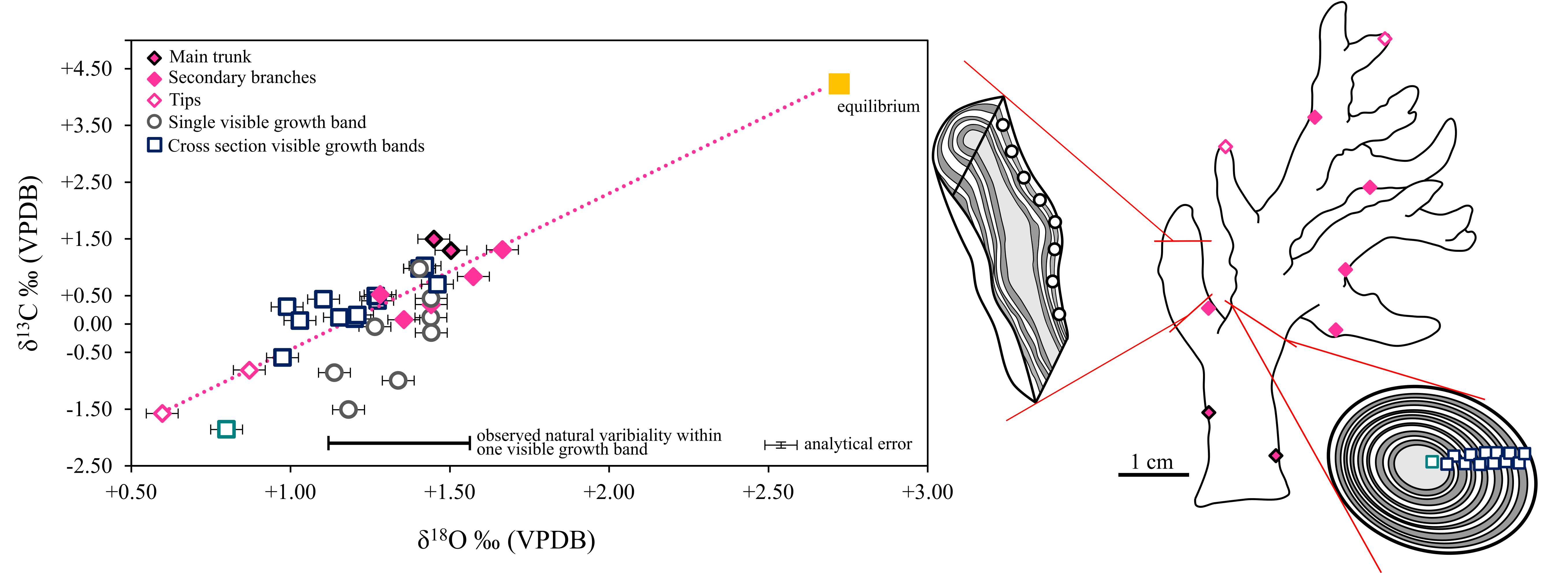Research
PhD thesis - Sclerochronological and geochemical records from Porites spp. in Fiji: Assessing massive coral response to environmental changes
My PhD thesis can be accessed here.
My project focused on disentangling how environmental and climate changes are impacting the growth of massive reef-building coral (Porites spp.) in Fiji, and how abrupt terrestrial discharges into coastal ecosystems and climatic events are linked to coral degradation.
I aim to disentangle the relationships between coral growth, water quality and climatic events in Fijian inshore reefs, and reconstruct the sensitivity of reef-building corals to environmental changes in the last few decades.
The main research aims we addressed are:
- To examine the variability of coral growth across different Fijian inshore reefs and across time.
- Evaluate the potential of Porites spp. as SST archive and analyse environmental controls on skeletal geochemistry.
- To examine the potential of Porites spp. as archives of terrigenous input into coastal areas, and the environmental and climatic controls.
Understanding the response of massive long-lived corals to environmental changes over time, as a result of climate and biogeochemical shifts, is critical for the assessment of the future of modern coral reefs.
To address these questions, I am using an interdisciplinary approach that couples traditional geochemical techniques (i.e. Ba/Ca, Mn/Ca, Sr/Ca,… measured via LA-ICPMS) and computed tomography (CT) to reconstruct seasonal changes in coral growth (i.e. linear extension, density and calcification) from massive long-lived Porites corals under a range of different catchment environments (agricultural, urban and forested) and a number of stress events (e.g. thermal stress, cyclones).
MRes - Stylasterids: A new paleoceanographic archive?
During my master’s project I worked on proxy development on stylasterid corals (Picture 1), specifically analysing whether oxygen stable isotopes (δ18O) can be used as a proxy for seawater temperature in these corals.
Stylasterids are a commonly found deep-sea coral taxon that build their skeletons from either calcite or aragonite (or both). Their potential as paleoceanographic archives remains unexplored and robust geochemical proxy data collected from modern specimens is very limited.
Oxygen and carbon (δ18O and δ13C) isotopic composition was measured in all the specimens. Five specimens were sub-sampled in the main trunk, secondary branches and growing tips. (Picture 2).The data indicate that environmental temperature is recorded in the skeletal chemistry of stylasterid corals. A global δ18O:temperature calibration for aragonitic stylasterids was produced. This calibration showed a mean depletion of 0.97‰ from equilibrium. This work highlights the potential application of stylasterid coral δ18O data to reconstruct ancient seawater temperature.
.jpg)

Output: Samperiz, A., Robinson, L., Stewart, J., Strawson, I., Leng, M., Rosenheim, B., Ciscato, E., Hendry, K., Santodomingo, N. 2020. Stylasterids: A new paleoceanographic archive. Earth and Planetary Science Letters 545:116407. doi:10.1016/j.epsl.2020.116407
BSc dissertation - Design, implementation and evaluation of an Environmental Education Program in a Summer Camp
At the end of my BSc program and as a 4th year research project I carried out an environmental education program at a summer camp in Spain. The need for solutions to face the actual environmental crisis has raised environmental education (EE) as an essential tool for formation and training whose main objective is turning people into responsible environmental citizens.
Since its inception in 1968 to the present, EE has been built in several national and international institutions, which have applied it from different approaches. However, non-formal EE has been more successful in looking for a critical reflection of our actual society.
The objective of this dissertation was the design, implementation and evaluation of a non-formal EE program in a summer camp called “Confluencias” (confluences), carried out in July 2014, and, also, gaining knowledge and attitude changes towards the environment in the camp participants: 76 teenagers between 14 and 17 years old. The program included activities around both natural and urban environments and the results showed that important differences in the participant’s attitudes towards the environment were reached, changing their perception on how the environment influences their daily lives.
To this day, this environmental program is still being carried out at “Confluencias” summer camp and has become an iterative project that evolves growing knowledge and worries of teenagers about climate change.
Output: Samperiz, A., Herrero, J. 2018. Evaluation of a summer camp environmental education program in Spain. Applied Environmental Education & Communication 17(1), 79-90. doi:10.1080/1533015X.2017.1366881
